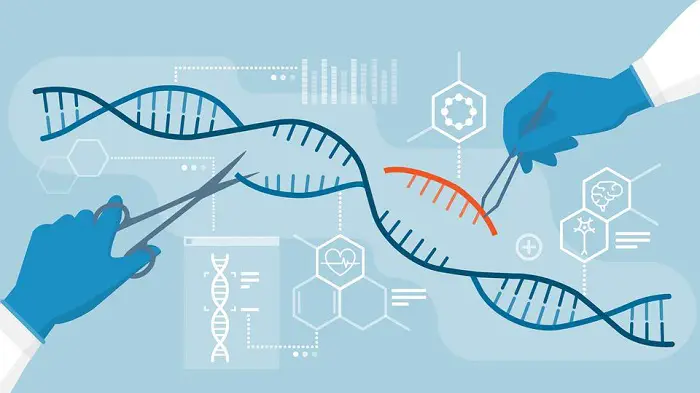Microbial genetic engineering, or genetic modification or recombinant DNA technology, involves manipulating the genetic material of microorganisms such as bacteria, fungi, or viruses to produce desired traits or perform specific functions. This field has numerous applications in biotechnology, medicine, agriculture, and environmental science.
The process typically involves isolating a specific gene or genes responsible for a desired trait from one organism and inserting them into the genome of another microorganism. This can be achieved using restriction enzyme digestion, DNA ligation, and transformation techniques. Once inserted, the new gene(s) can be expressed by the host organism, producing proteins or metabolites with desired properties.
Application of Microbial Genetic Engineering
Microbial genetic engineering has a wide range of applications, including:
- Industrial Biotechnology: Microorganisms can be engineered to produce valuable products such as enzymes, antibiotics, biofuels, and various chemicals on a large scale. For example, bacteria like Escherichia coli and yeast species such as Saccharomyces cerevisiae are commonly used as host organisms for producing recombinant proteins and biofuels.
- Agriculture: Genetically modified microorganisms can be used in agriculture to enhance crop growth, improve nutrient uptake, or protect against pests and diseases. For instance, some bacteria have been engineered to increase nitrogen fixation in soil, reducing the need for synthetic fertilizers.
- Medicine: Microbial genetic engineering is crucial in producing therapeutic proteins, vaccines, and antibiotics. For example, the bacterium Escherichia coli is often used to produce insulin for treating diabetes, while yeast cells can be engineered to produce vaccines against infectious diseases.
- Environmental Remediation: Engineered microorganisms can clean up environmental pollutants or degrade toxic substances. Certain bacteria have been modified to break down pollutants such as oil spills, heavy metals (Cd, Pb, Cr, etc), and industrial waste.
- Research: Microbial genetic engineering is essential for studying microorganisms’ gene function, protein expression, and metabolic pathways. It enables researchers to understand biological processes better and develop new technologies for various applications.
Microbial genetic engineering offers a powerful toolkit for manipulating microorganisms to address various societal challenges and improve human health, agriculture, and the environment. However, it also raises ethical, safety, and regulatory considerations that must be mainly addressed to ensure responsible and sustainable use of this technology.
Concepts of Microbial Genetic Engineering
Genetic engineering involves manipulating the genetic material of organisms to achieve specific outcomes. Here are some basic concepts:
- DNA: DNA (deoxyribonucleic acid) is the molecule that contains the genetic instructions for the development, functioning, growth, and reproduction of all living organisms. It consists of two long strands arranged in a double helix structure comprising nucleotide building blocks.
- Genes: Genes are segments of DNA that encode specific traits or characteristics. They serve as the blueprint for producing proteins essential for various biological processes.
- Recombinant DNA: Recombinant DNA is created by combining DNA molecules from different sources. This process involves cutting DNA fragments using restriction enzymes and joining them together using DNA ligase. Recombinant DNA technology allows scientists to transfer genes between organisms and create new genetic combinations.
- Vectors: Vectors are carrier molecules used to transport foreign DNA into host organisms. Typical vectors include plasmids (small circular DNA molecules found in bacteria), viruses, and artificial chromosomes. Vectors are manipulated in the laboratory to carry desired genes into target cells.
- Transformation: Transformation is the process of introducing foreign DNA into a host organism’s cells. In bacteria, transformation involves the uptake of DNA from the surrounding environment. Other methods, such as electroporation and gene guns, can introduce DNA into plant and animal cells.
- Gene Cloning: Gene cloning involves making multiple copies of a specific gene or DNA sequence. This technique allows researchers to study and manipulate individual genes, produce large quantities of proteins for research or commercial purposes, and create genetically modified organisms (GMOs).
- Gene Expression: Gene expression refers to the process by which information embedded in a gene is used to produce a functional product, typically a protein. Gene expression involves transcription (the synthesis of RNA from DNA) and translation (protein synthesis from RNA). Genetic engineering can modify gene expression to increase or decrease the production of specific proteins.
- CRISPR-Cas9: CRISPR-Cas9 is a revolutionary gene-editing technology that allows precise modifications to the DNA sequence of organisms. It uses a bacterial enzyme called Cas9 and a guide RNA molecule to target specific DNA sequences and make changes such as insertions, deletions, or substitutions. CRISPR-Cas9 has numerous applications in genetic engineering, including gene therapy, crop improvement, and disease research.
These are just a few basic concepts of genetic engineering. The field is vast and constantly evolving, with new techniques and applications being developed to manipulate and utilize genetic information for various purposes.

